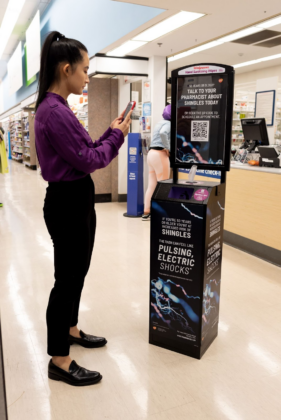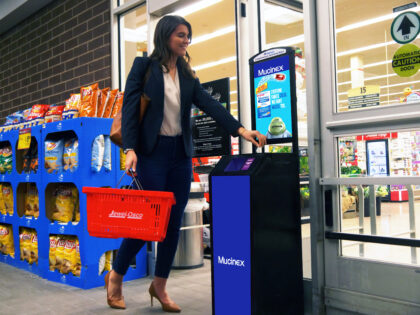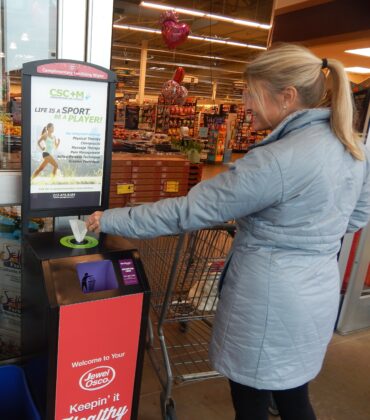Considering doctor office advertising?
You may be thinking that advertising inside a doctors office is the best way to reach patients.
While there are some pros to this type of advertising, there are also drawbacks people fail to mention.
If you’re in one of these professions, this is for you:
- Pharmaceutical Marketer
- Wellness Brand Marketer
- Insurance Company Marketer
- Gym Owner
- Nutritionist
- Physical therapist
- Chiropractor
- Optometrist
- Dentist
- Therapist
Lobby Advertising
Before seeing a doctor, patients will have to spend time in the lobby checking in, filling out forms, and waiting to be called. Waiting in the lobbies of doctor’s offices can be an annoyance to patients, but it does provide healthcare advertisers with a captive audience.
Lobbies can be a good space for advertising mediums like posters, digital signage, and brochures. However, there are some significant downsides to this advertising real estate.
- Lack of engagement: Patients are checking in, filling out forms, or going on their phones in the doctor’s lobby. On top of that, these patients are usually fixated on their health concerns and aren’t primed to engage with their surroundings and connect with an advertised brand.
- Limited reach: Increasing brand exposure is all about getting consumers to view your ads at a high frequency. With doctor office advertising, patients will only book appointments once or twice a year. Alternatively, consumers see pharmacy wait area advertising at a high frequency everytime they fill up their prescription.
- Exposure time: By the time patients have completed their check in forms, it doesn’t take long for them to be called in for their appointment. Since time is limited and patients are mostly preoccupied, the exposure of lobby room advertising is severely limited. If they are waiting a long time, they’re likely to be glued to their phones.
Waiting Room & Exam Room Advertising (In-Office Ads)
Patients are somewhat less preoccupied in waiting rooms and exam rooms since they’ll be attentively waiting for doctors and nurses to enter the room.
Despite patients being a bit more engaged with their surroundings, this ad space does still have many of the same issues from lobby advertising: patients are preoccupied with their health and the exposure is limited.
On top of that, this is where patients sometimes feel the most negative emotions as they nervously wait for their doctor. This isn’t ideal because consumers are much more likely to make connections with brands and purchase decisions in a relaxed environment.
Back Office Advertising
Back office advertising targets healthcare professionals and staff. These advertisements are featured in the administrative areas of hospitals and other medical practices to efficiently disseminate their latest company-specific information as well as relevant news from the wider medical community. This information can come in the form of bulletin boards, email communications, staff newsletters, or even training and educational programs.
If you’re trying to advertise your practice or brand, this type of advertising won’t be that useful to you.
Wellness Boards
Your brand can be boosted by the contextual setting of a doctor’s office, but you probably won’t get the best return on your investment. If you’re looking for a similar healthcare setting with better engagement, wellness billboards in pharmacy wait areas may be your best option.
Wellness billboards feature sponsored advertisements above a sanitizing wipe dispenser and are immensely successful in targeting health-conscious consumers. Since these wellness billboards can be displayed at pharmacy wait areas, store fronts, and even gyms, your brand can be seen at a high frequency that ensures a boost in recognition.
When they grab a wipe, they step into a geofence that allows you to retarget them on their mobile device so you stay front-of-mind with customers.
We’re the industry leader in this ad space and independent studies have shown that 80% of shoppers interact with sanitizing kiosks and 94% have a positive opinion of the companies sponsoring wellness billboards.
Doctors Office Advertising Examples
Wellness Boards Inside CVS & Walgreens
We have partnerships with both CVS and Walgreens to prominently display both digital and nondigital sanitizing billboards in pharmacy wait areas. What makes these displays so effective is that they get shoppers to stop for a moment, take a hand wipe, and look at the promotional material.
These billboards can even be equipped with geofencing tools that use anonymized data to retarget consumers with online ads on their mobile devices the next time they use a search engine or other internet platforms. This is great for synergizing your in-store advertising with your online content.
AHF Healthcare Center’s Exam Room Advertising
In 2016, a small region of rural Southern Indiana experienced an outbreak of HIV cases. As part of an effort to increase testing and awareness of how HIV spreads, Indiana’s State Department of Health distributed posters and brochures to be prominently displayed in doctor offices and exam rooms.
Digital OOH Advertising in Lobbies
Digital out-of-home (DOOH) advertising can be immensely effective in healthcare settings and provide patients with engaging content with alternating images or even animated displays. What’s great about DOOH advertising is that you can utilize programmatic options that will only display your ads when the correct conditions have been met, such as the number of patients in the lobby or specific time of day.
If you’re interested in learning more, you can dive into different healthcare advertisement techniques to make your campaign more effective.
Flu Shot Promotions in Urgent Care Facilities
These posters are a great example of point-of-care advertising, which reaches patients when they are most open to additional healthcare treatments. By promoting flu vaccines in their urgent care clinics, the Minute Clinic was able to increase the chances that patients will ask health care professionals about getting vaccinated and further increase the likelihood of them getting the shot.
These are just several examples of all the advertising and marketing strategies in healthcare.
Effective Advertising to Reach Patients
We’ve seen clinics and healthcare professionals make costly mistakes that could have been easily avoided.
The effectiveness of our wellness billboards is backed by studies that have shown 94% of consumers have a positive opinion of the company that sponsors a wellness billboard and 50% take a coupon or brochure to learn more.
If you want more patients, you need the right advertising strategy.
Get in touch and we’ll help you craft the perfect campaign every step of the way.



